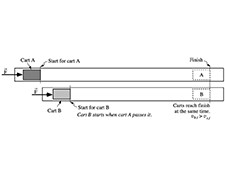
Changes in energy and momentum
Variant i Dynamics first
Developed by Tara Obrien-Pride (creator), Peter Shaffer (contributor), and Paula Heron (contributor)
The tutorial helps students apply the work-energy and impulse-momentum theorems to simple motions.
Topics Mechanics / Energy: systems, energy, energy conservation, and forces
Materials
Materials by the UW team
- Equipment List

- Instructor’s Guide


- Sample Pre-test


- Handout


- Sample Exam Questions



Tutorial details
In the first section of the tutorial, students revisit the situation presented on the pretest. In part A, they are asked to consider a fictionalized discussion involving inappropriate compensation arguments similar to the ones that they may have used themselves on the pretest. At this early stage of the tutorial, instructors are encouraged to let students proceed without addressing their difficulties. At the end of the section, students check their reasoning with a staff member. At this point, students should have come to disagree with students 2 and 3 quoted in part A and to be able to articulate the errors in reasoning involved. They should be able to explain that the kinetic energies are equal using the work-energy theorem and that the momentum of the heavier cart is greater since it spent more time to cover the same distance, and thus received a greater impulse from the force.
In part II of the tutorial, students analyze the motion of a ball rolling down a ramp under two different conditions. In motion 1, the ball arrives at the top of the ramp with a velocity perpendicular to the boundary. In motion 2, the ball arrives at the top of the ramp with the same speed as before but at an acute angle with the boundary. The questions in the tutorial guide the students through the steps in reasoning that are necessary for them to recognize that the magnitudes of the initial momenta are the same in the two cases, as are the magnitudes of the final momenta. Students are also led to conclude that the change in momentum is greater in the case in which the initial and final momentum vectors are not collinear. They infer that the ball spends a longer time on the ramp in that case and conclude that this is consistent with kinematical considerations based on constant acceleration on the ramp.
For instruction tips, login or register as a verified educator to see the Instructor Guide.
Prerequisites
Prerequisite tutorials
The Acceleration in one-dimension, Motion in two dimensions, and Forces tutorials are prerequisites to Changes in energy and momentum.
Other prerequisites
The tutorials Acceleration in one dimension, Motion in two dimensions, and Forces provide useful background. The work-energy theorem should have been previously covered in class. The second section on applying the work-energy and impulse momentum theorems is hard for many students and is most appropriate for students in an honors course.
Equipment
Special Instructions
Note: Make one copy of each page in the handouts for each group (enlarged to 125%). Place each on the ramps as shown in the figure below.

List
- handouts
- small balls
- starting wedges (small wood ramps)
- white board or large sheet of paper with markers
- cardboard ramps (see figure in Instructor's guide)
Research
- R. Lawson and L. McDermott, Student understanding of the work-energy and impulse-momentum theorems, Am. J. Phys. 55 (9), 811 (1987).
- T. O'Brien Pride, S. Vokos, and L. McDermott, The challenge of matching learning assessments to teaching goals: An example from the work-energy and impulse-momentum theorems, Am. J. Phys. 66 (2), 147 (1998).
Coming Soon! We hope to release the discussion section on each tutorial by the end of July 2024.

